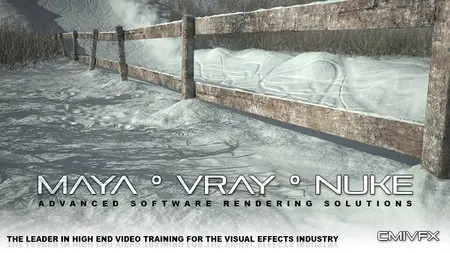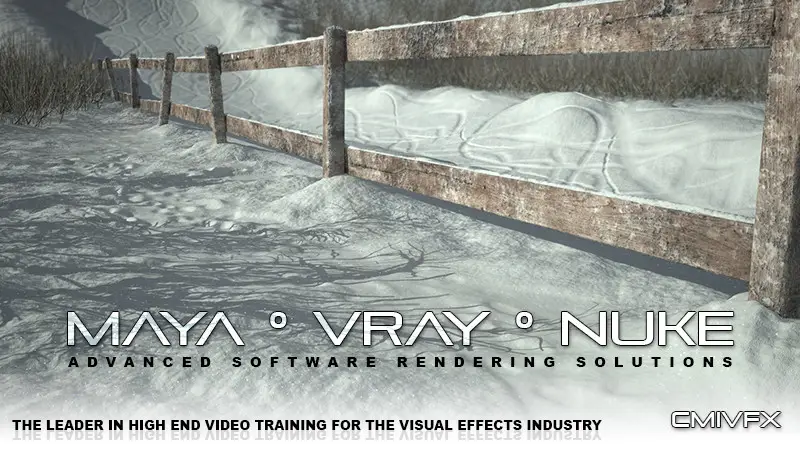cmiVFX - Maya VRay Nuke
English | MP4 | AVC1 1024x576 12 fps | AAC 38 Kbps 22.05 KHz | 1 Gb
Genre: eLearning
This project based course takes on the challenge of a snowy landscape. Snowy visuals in animation are quite complex and can be a challenge to the most experienced TD. The organic shape, depth and sparkles of snow are all difficult features. Together in a single scene they can be maddening. Paolo Copponi has taken on this challenge. Paolo will model in maya, shade in VRay, and compose in nuke. Every stage of this complex scene is covered in detail. This beginning-to-end approach in a lesson, takes the student from a blank screen to a complete REEL clip. This production pipeline is intended to achieve the balance between quality and speed that can be difficult with VRay. VRay materials, lighting and rendering can be a bear. He takes VRay further by setting up passes and elements for NUKE compositing. The VRay to NUKE pipe alone is worth this small cost. This is an intermediate to advanced lesson. The tools taught here require: Maya, VRay, Nuke and Photoshop. Trial versions of each should suffice to follow along.
Chapter Descriptions
Snowy landscape in Maya and VRay
Project Overview
In this series of lessons we will explore the techniques for create a realistic snowy landscape using VRay in Maya , Nuke and Photoshop. In this first chapter I will explain the structure of the project and I will show you all the parts that we will find along this learning path.
Modeling The Scene
In this section we are going to see the modeling techniques for the base of snow and fence, and the use of Maya visor to build the vegetation.
VRay Settings and Lighting The Scene
This section shows how to setup the VRay rendering engine, in particular i will show how to use the environment setting (gi, reflection and refraction texture), and the Indirect illumination setting. VRay has different type of light but for this tutorial we will use the VRayGeoSun and the VRayLightRect.
VRay Materials
The VRay materials are provided with a V-ray renderer. In this section I will show the principal materials that we are going to use in the next chapter for the construction of snow shader. The materials that will use are: VRayMtl, VRayFastSSS2, VRayBlendMtl and VRayBumpMtl.
Snow Displacement Map
This is one of the most important part for the creation of a snowy landscape. I will show how create ad UV texture map for the snow, how export the map in Photoshop and how to create a correct displacement map. The fundamental thing for the creation of the snow is the displacement map and how it works.
Snow Shader
In this area I will show how to create a shader for the snow through the materials that we learned in chapter 4 and I will explain how create the sparkles effects for the snow. We will use Photoshop to create a map for sparkles.
Ice Fence and Vegetation Shader
In this chapter I will show you how create a shader with an ice effect for the fence and vegetation. We will create a UV map for the object and then we will create a texture for this element in Photoshop.
Render Snow And Sparkles In Different Render Elements
To create the sparkles effect we need to render the snow and sparks separately using the "material select" render element. This will be useful in the last chapter when we will compose the scene in Nuke.
VRay Render Elements
Overview of the most important render elements. I will show how to export different render elements to obtain a total control of the image in Nuke. In particular we will see two new render elements, The V-ray multi matte and the V-ray Z-depth.
Nuke Bonus
In this last chapter we will learn how compose the VRay render elements in Nuke. We will do some adjustment for the color correction, we will add a depth of field and a glint to the sparkles.
Bonus Chapter
In this chapter we will see how to adjust all the nodes in nuke for the animation.
About The Instructor
Paolo Copponi is 27 years old and I come from Italy. I'm a 3D Maya Artist specializes in VFX, Lighting & Rendering and Digital sets. Currently I'm based in Italy and I work as a freelance. In 2010 I obtained the university degree in theory and techniques of visual communication and multimedia from the Academy of fine Arts in Macerata (Italy), with vote 110/110 cum laude. In 2011 I went to Los angeles and I specialized in 3d visual effects.
Project Contents
All cmiVFX videos come with all the training materials you can need right from our website. No matter what time of day, your location, or how your feeling, cmiVFX will be there waiting for you!



